fuel pressure FIAT FIORINO 2013 Owner handbook (in English)
[x] Cancel search | Manufacturer: FIAT, Model Year: 2013, Model line: FIORINO, Model: FIAT FIORINO 2013Pages: 210, PDF Size: 4.9 MB
Page 9 of 210
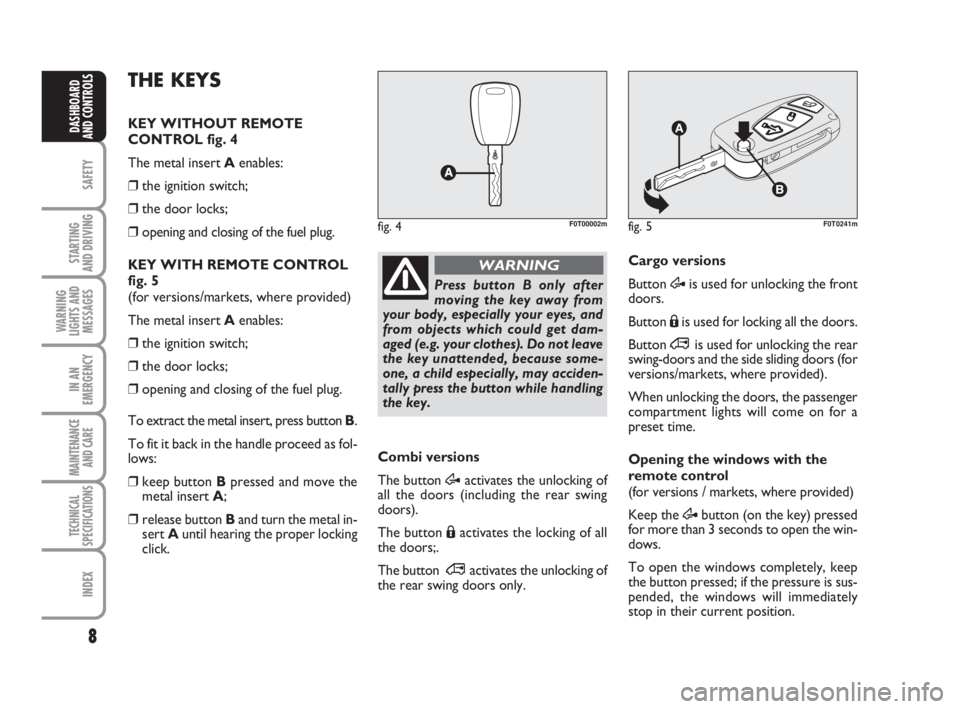
8
SAFETY
STARTING
AND DRIVING
WARNING
LIGHTS AND
MESSAGES
IN AN
EMERGENCY
MAINTENANCE
AND CARE
TECHNICAL
SPECIFICATIONS
INDEX
DASHBOARD
AND CONTROLS
Press button B only after
moving the key away from
your body, especially your eyes, and
from objects which could get dam-
aged (e.g. your clothes). Do not leave
the key unattended, because some-
one, a child especially, may acciden-
tally press the button while handling
the key.
WARNING
THE KEYS
KEY WITHOUT REMOTE
CONTROL fig. 4
The metal insert Aenables:
❒the ignition switch;
❒the door locks;
❒opening and closing of the fuel plug.
KEY WITH REMOTE CONTROL
fig. 5
(for versions/markets, where provided)
The metal insert Aenables:
❒the ignition switch;
❒the door locks;
❒opening and closing of the fuel plug.
To extract the metal insert, press button B.
To fit it back in the handle proceed as fol-
lows:
❒keep button Bpressed and move the
metal insert A;
❒release button Band turn the metal in-
sert Auntil hearing the proper locking
click.Combi versions
The button Æactivates the unlocking of
all the doors (including the rear swing
doors).
The button Áactivates the locking of all
the doors;.
The button
∞activates the unlocking of
the rear swing doors only.
fig. 4F0T00002mfig. 5F0T0241m
Cargo versions
Button Æis used for unlocking the front
doors.
Button Áis used for locking all the doors.
Button
∞is used for unlocking the rear
swing-doors and the side sliding doors (for
versions/markets, where provided).
When unlocking the doors, the passenger
compartment lights will come on for a
preset time.
Opening the windows with the
remote control
(for versions / markets, where provided)
Keep the Æbutton (on the key) pressed
for more than 3 seconds to open the win-
dows.
To open the windows completely, keep
the button pressed; if the pressure is sus-
pended, the windows will immediately
stop in their current position.
001-035 Fiorino GB 1ed:001-035 Fiorino GB 1ed 2-12-2009 16:14 Pagina 8
Page 32 of 210
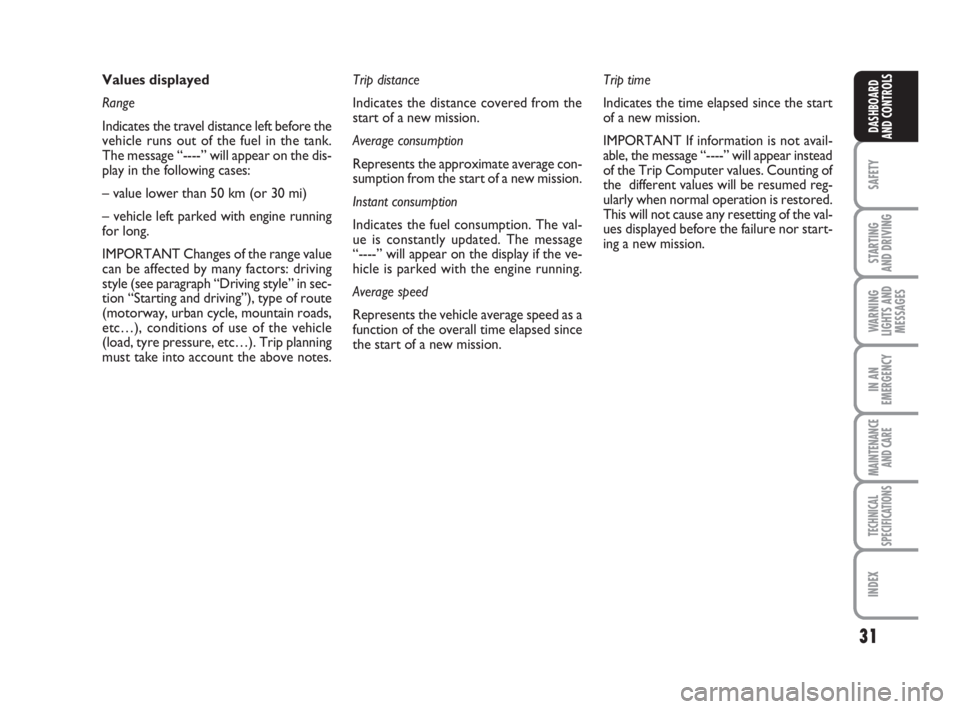
31
SAFETY
STARTING
AND DRIVING
WARNING
LIGHTS AND
MESSAGES
IN AN
EMERGENCY
MAINTENANCE
AND CARE
TECHNICAL
SPECIFICATIONS
INDEX
DASHBOARD
AND CONTROLS
Values displayed
Range
Indicates the travel distance left before the
vehicle runs out of the fuel in the tank.
The message “----” will appear on the dis-
play in the following cases:
– value lower than 50 km (or 30 mi)
– vehicle left parked with engine running
for long.
IMPORTANT Changes of the range value
can be affected by many factors: driving
style (see paragraph “Driving style” in sec-
tion “Starting and driving”), type of route
(motorway, urban cycle, mountain roads,
etc…), conditions of use of the vehicle
(load, tyre pressure, etc…). Trip planning
must take into account the above notes.Trip distance
Indicates the distance covered from the
start of a new mission.
Average consumption
Represents the approximate average con-
sumption from the start of a new mission.
Instant consumption
Indicates the fuel consumption. The val-
ue is constantly updated. The message
“----” will appear on the display if the ve-
hicle is parked with the engine running.
Average speed
Represents the vehicle average speed as a
function of the overall time elapsed since
the start of a new mission.Trip time
Indicates the time elapsed since the start
of a new mission.
IMPORTANT If information is not avail-
able, the message “----” will appear instead
of the Trip Computer values. Counting of
the different values will be resumed reg-
ularly when normal operation is restored.
This will not cause any resetting of the val-
ues displayed before the failure nor start-
ing a new mission.
001-035 Fiorino GB 1ed:001-035 Fiorino GB 1ed 2-12-2009 16:14 Pagina 31
Page 83 of 210
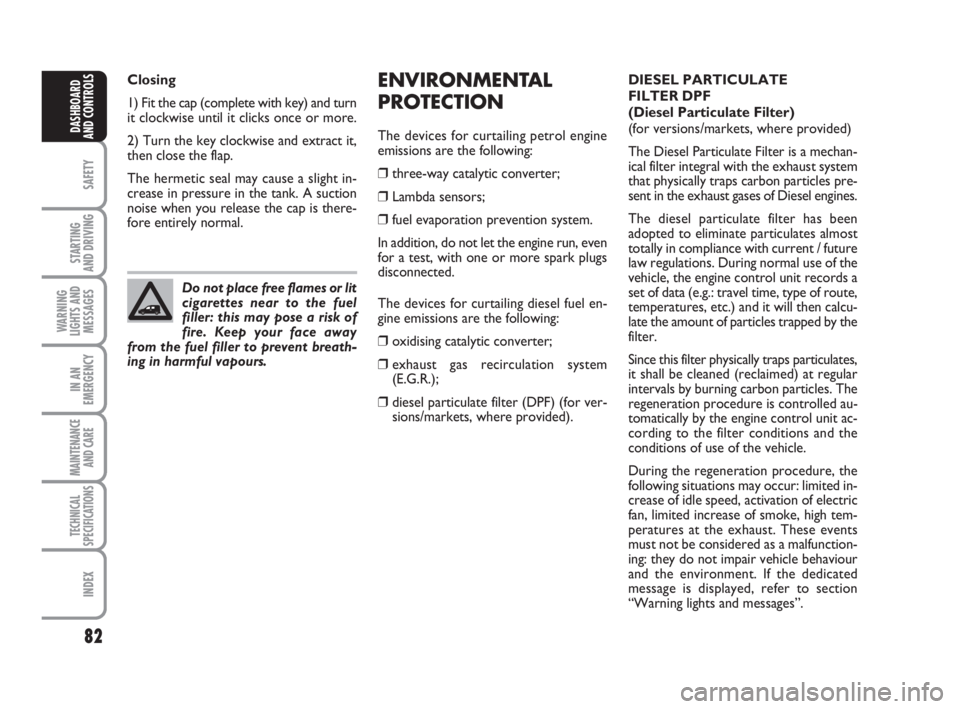
82
SAFETY
STARTING
AND DRIVING
WARNING
LIGHTS AND
MESSAGES
IN AN
EMERGENCY
MAINTENANCE
AND CARE
TECHNICAL
SPECIFICATIONS
INDEX
DASHBOARD
AND CONTROLS
ENVIRONMENTAL
PROTECTION
The devices for curtailing petrol engine
emissions are the following:
❒three-way catalytic converter;
❒Lambda sensors;
❒fuel evaporation prevention system.
In addition, do not let the engine run, even
for a test, with one or more spark plugs
disconnected.
The devices for curtailing diesel fuel en-
gine emissions are the following:
❒oxidising catalytic converter;
❒exhaust gas recirculation system
(E.G.R.);
❒diesel particulate filter (DPF) (for ver-
sions/markets, where provided). Do not place free flames or lit
cigarettes near to the fuel
filler: this may pose a risk of
fire. Keep your face away
from the fuel filler to prevent breath-
ing in harmful vapours.
DIESEL PARTICULATE
FILTER DPF
(Diesel Particulate Filter)
(for versions/markets, where provided)
The Diesel Particulate Filter is a mechan-
ical filter integral with the exhaust system
that physically traps carbon particles pre-
sent in the exhaust gases of Diesel engines.
The diesel particulate filter has been
adopted to eliminate particulates almost
totally in compliance with current / future
law regulations. During normal use of the
vehicle, the engine control unit records a
set of data (e.g.: travel time, type of route,
temperatures, etc.) and it will then calcu-
late the amount of particles trapped by the
filter.
Since this filter physically traps particulates,
it shall be cleaned (reclaimed) at regular
intervals by burning carbon particles. The
regeneration procedure is controlled au-
tomatically by the engine control unit ac-
cording to the filter conditions and the
conditions of use of the vehicle.
During the regeneration procedure, the
following situations may occur: limited in-
crease of idle speed, activation of electric
fan, limited increase of smoke, high tem-
peratures at the exhaust. These events
must not be considered as a malfunction-
ing: they do not impair vehicle behaviour
and the environment. If the dedicated
message is displayed, refer to section
“Warning lights and messages”. Closing
1) Fit the cap (complete with key) and turn
it clockwise until it clicks once or more.
2) Turn the key clockwise and extract it,
then close the flap.
The hermetic seal may cause a slight in-
crease in pressure in the tank. A suction
noise when you release the cap is there-
fore entirely normal.
036-082 Fiorino GB 1ed:036-082 Fiorino GB 1ed 30-11-2009 15:47 Pagina 82
Page 107 of 210
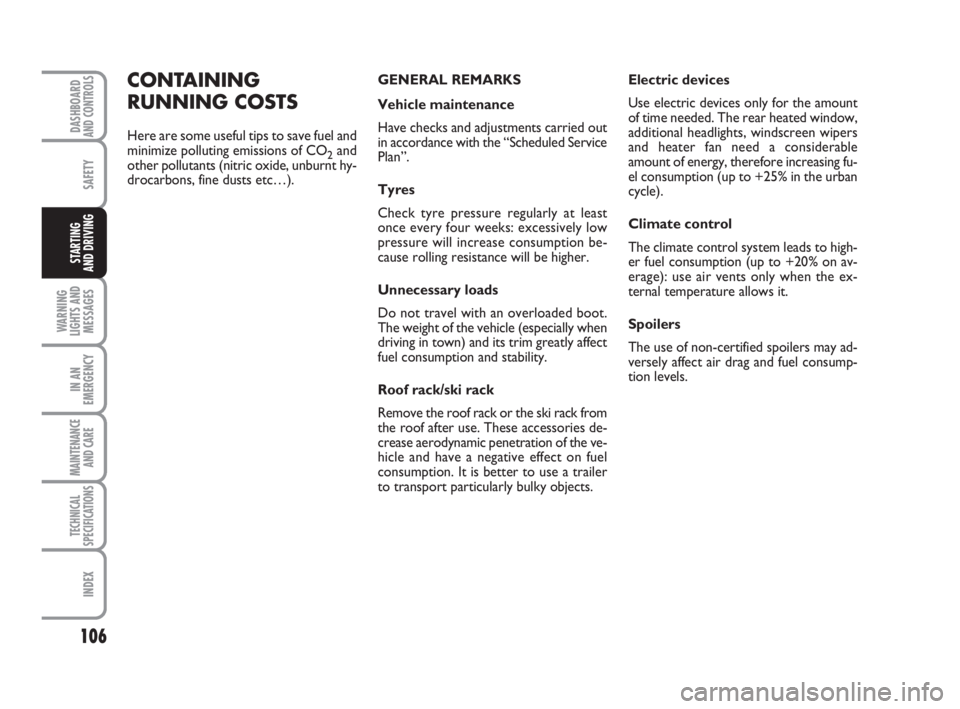
106
SAFETY
WARNING
LIGHTS AND
MESSAGES
IN AN
EMERGENCY
MAINTENANCE
AND CARE
TECHNICAL
SPECIFICATIONS
INDEX
DASHBOARDAND CONTROLS
STARTING
AND DRIVING
CONTAINING
RUNNING COSTS
Here are some useful tips to save fuel and
minimize polluting emissions of CO
2and
other pollutants (nitric oxide, unburnt hy-
drocarbons, fine dusts etc…).GENERAL REMARKS
Vehicle maintenance
Have checks and adjustments carried out
in accordance with the “Scheduled Service
Plan”.
Tyres
Check tyre pressure regularly at least
once every four weeks: excessively low
pressure will increase consumption be-
cause rolling resistance will be higher.
Unnecessary loads
Do not travel with an overloaded boot.
The weight of the vehicle (especially when
driving in town) and its trim greatly affect
fuel consumption and stability.
Roof rack/ski rack
Remove the roof rack or the ski rack from
the roof after use. These accessories de-
crease aerodynamic penetration of the ve-
hicle and have a negative effect on fuel
consumption. It is better to use a trailer
to transport particularly bulky objects.Electric devices
Use electric devices only for the amount
of time needed. The rear heated window,
additional headlights, windscreen wipers
and heater fan need a considerable
amount of energy, therefore increasing fu-
el consumption (up to +25% in the urban
cycle).
Climate control
The climate control system leads to high-
er fuel consumption (up to +20% on av-
erage): use air vents only when the ex-
ternal temperature allows it.
Spoilers
The use of non-certified spoilers may ad-
versely affect air drag and fuel consump-
tion levels.
101-110 Fiorino GB 1ed:101-110 Fiorino GB 1ed 30-11-2009 16:14 Pagina 106
Page 112 of 210
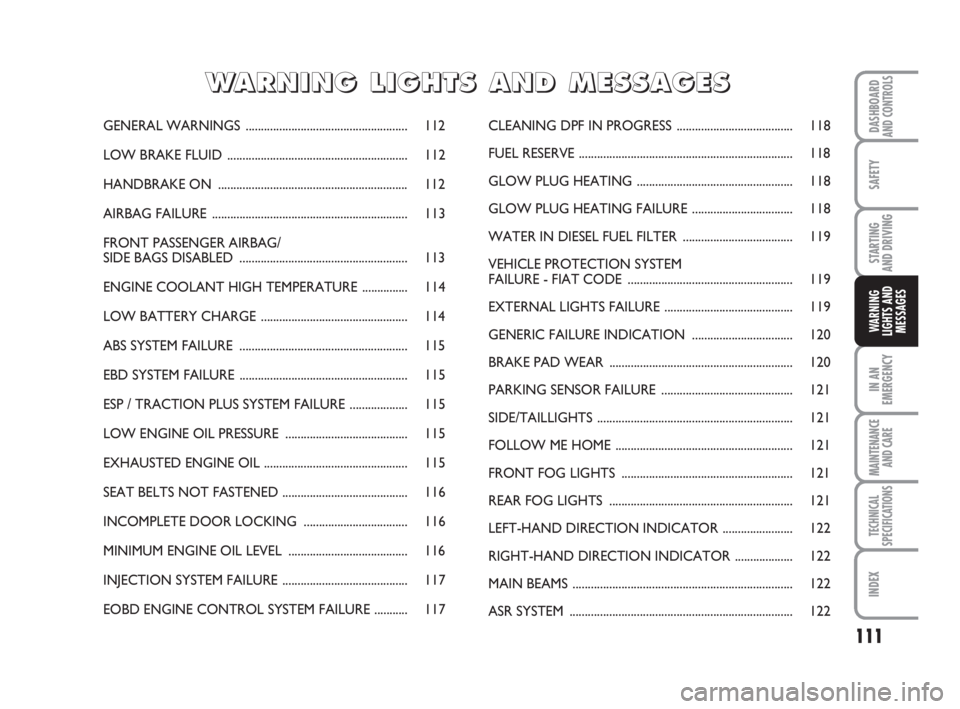
111
SAFETY
IN AN
EMERGENCY
MAINTENANCE
AND CARE
TECHNICAL
SPECIFICATIONS
INDEX
DASHBOARDAND CONTROLS
STARTING
AND DRIVING
WARNING
LIGHTS AND
MESSAGES
GENERAL WARNINGS ..................................................... 112
LOW BRAKE FLUID........................................................... 112
HANDBRAKE ON .............................................................. 112
AIRBAG FAILURE................................................................ 113
FRONT PASSENGER AIRBAG/
SIDE BAGS DISABLED....................................................... 113
ENGINE COOLANT HIGH TEMPERATURE ............... 114
LOW BATTERY CHARGE ................................................ 114
ABS SYSTEM FAILURE....................................................... 115
EBD SYSTEM FAILURE ....................................................... 115
ESP / TRACTION PLUS SYSTEM FAILURE ................... 115
LOW ENGINE OIL PRESSURE........................................ 115
EXHAUSTED ENGINE OIL............................................... 115
SEAT BELTS NOT FASTENED ......................................... 116
INCOMPLETE DOOR LOCKING .................................. 116
MINIMUM ENGINE OIL LEVEL....................................... 116
INJECTION SYSTEM FAILURE......................................... 117
EOBD ENGINE CONTROL SYSTEM FAILURE ........... 117CLEANING DPF IN PROGRESS...................................... 118
FUEL RESERVE ...................................................................... 118
GLOW PLUG HEATING................................................... 118
GLOW PLUG HEATING FAILURE................................. 118
WATER IN DIESEL FUEL FILTER.................................... 119
VEHICLE PROTECTION SYSTEM
FAILURE - FIAT CODE ...................................................... 119
EXTERNAL LIGHTS FAILURE.......................................... 119
GENERIC FAILURE INDICATION ................................. 120
BRAKE PAD WEAR ............................................................ 120
PARKING SENSOR FAILURE........................................... 121
SIDE/TAILLIGHTS................................................................ 121
FOLLOW ME HOME .......................................................... 121
FRONT FOG LIGHTS........................................................ 121
REAR FOG LIGHTS............................................................ 121
LEFT-HAND DIRECTION INDICATOR ....................... 122
RIGHT-HAND DIRECTION INDICATOR ................... 122
MAIN BEAMS........................................................................ 122
ASR SYSTEM ......................................................................... 122
W W
A A
R R
N N
I I
N N
G G
L L
I I
G G
H H
T T
S S
A A
N N
D D
M M
E E
S S
S S
A A
G G
E E
S S
111-122 Fiorino GB 1ed:111-122 Fiorino GB 1ed 2-12-2009 16:18 Pagina 111
Page 121 of 210
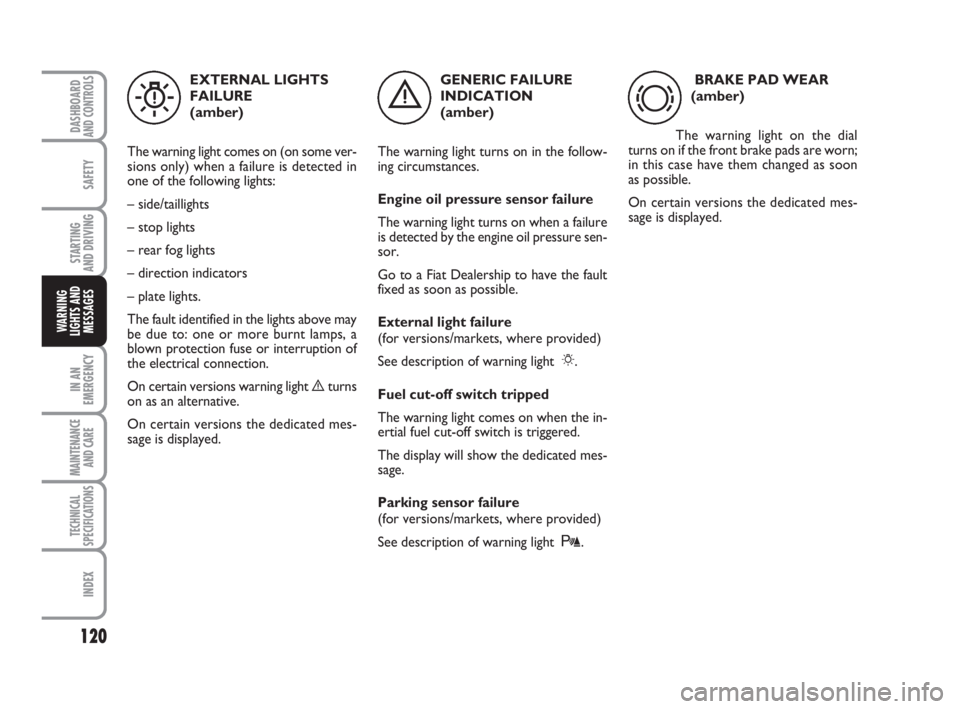
120
SAFETY
IN AN
EMERGENCY
MAINTENANCE
AND CARE
TECHNICAL
SPECIFICATIONS
INDEX
DASHBOARDAND CONTROLS
STARTING
AND DRIVING
WARNING
LIGHTS AND
MESSAGES
GENERIC FAILURE
INDICATION
(amber)
The warning light turns on in the follow-
ing circumstances.
Engine oil pressure sensor failure
The warning light turns on when a failure
is detected by the engine oil pressure sen-
sor.
Go to a Fiat Dealership to have the fault
fixed as soon as possible.
External light failure
(for versions/markets, where provided)
See description of warning light 6.
Fuel cut-off switch tripped
The warning light comes on when the in-
ertial fuel cut-off switch is triggered.
The display will show the dedicated mes-
sage.
Parking sensor failure
(for versions/markets, where provided)
See description of warning light t.BRAKE PAD WEAR
(amber)
The warning light on the dial
turns on if the front brake pads are worn;
in this case have them changed as soon
as possible.
On certain versions the dedicated mes-
sage is displayed.
èd
EXTERNAL LIGHTS
FAILURE
(amber)
The warning light comes on (on some ver-
sions only) when a failure is detected in
one of the following lights:
– side/taillights
– stop lights
– rear fog lights
– direction indicators
– plate lights.
The fault identified in the lights above may
be due to: one or more burnt lamps, a
blown protection fuse or interruption of
the electrical connection.
On certain versions warning light èturns
on as an alternative.
On certain versions the dedicated mes-
sage is displayed.
W
111-122 Fiorino GB 1ed:111-122 Fiorino GB 1ed 2-12-2009 16:18 Pagina 120
Page 158 of 210
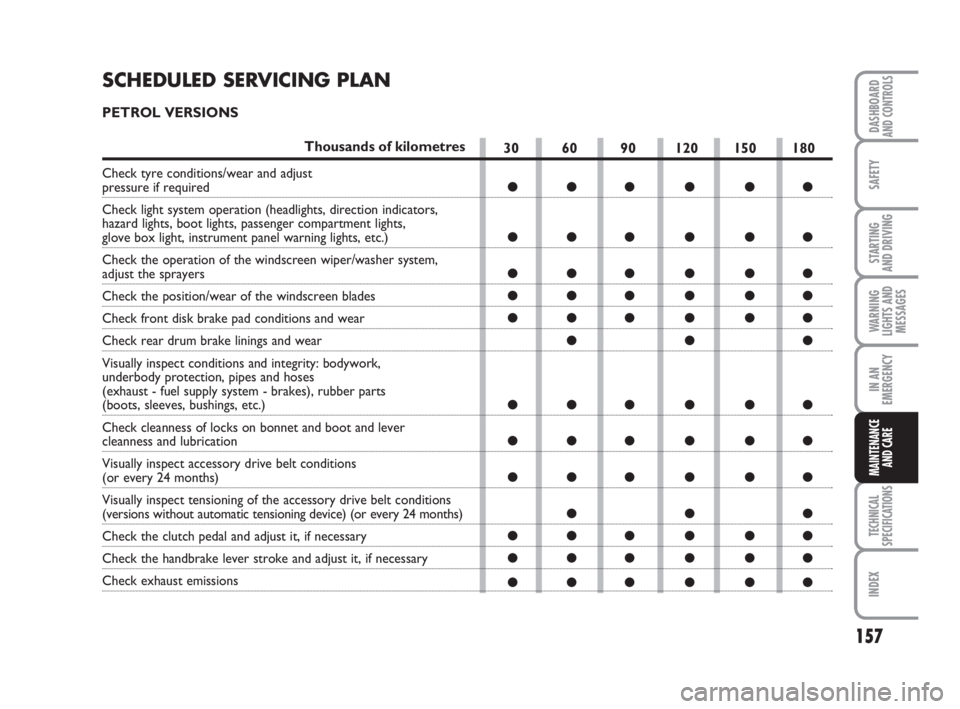
157
SAFETY
TECHNICAL
SPECIFICATIONS
INDEX
DASHBOARDAND CONTROLS
STARTING
AND DRIVING
WARNING
LIGHTS AND
MESSAGES
IN AN
EMERGENCY
MAINTENANCE
AND CARE
30 60 90 120 150 180
●●●●●●
●●●●●●
●●●●●●
●●●●●●
●●●●●●
●●●
●●●●●●
●●●●●●
●●●●●●
●●●
●●●●●●
●●●●●●
●●●●●●
SCHEDULED SERVICING PLAN
PETROL VERSIONS
Thousands of kilometres
Check tyre conditions/wear and adjust pressure if required
Check light system operation (headlights, direction indicators,
hazard lights, boot lights, passenger compartment lights,
glove box light, instrument panel warning lights, etc.)
Check the operation of the windscreen wiper/washer system,
adjust the sprayers
Check the position/wear of the windscreen blades
Check front disk brake pad conditions and wear
Check rear drum brake linings and wear
Visually inspect conditions and integrity: bodywork,
underbody protection, pipes and hoses
(exhaust - fuel supply system - brakes), rubber parts
(boots, sleeves, bushings, etc.)
Check cleanness of locks on bonnet and boot and lever
cleanness and lubrication
Visually inspect accessory drive belt conditions
(or every 24 months)
Visually inspect tensioning of the accessory drive belt conditions
(versions without automatic tensioning device) (or every 24 months)
Check the clutch pedal and adjust it, if necessary
Check the handbrake lever stroke and adjust it, if necessary
Check exhaust emissions
155-176 Fiorino GB 1ed:155-176 Fiorino GB 1ed 30-11-2009 16:34 Pagina 157
Page 160 of 210
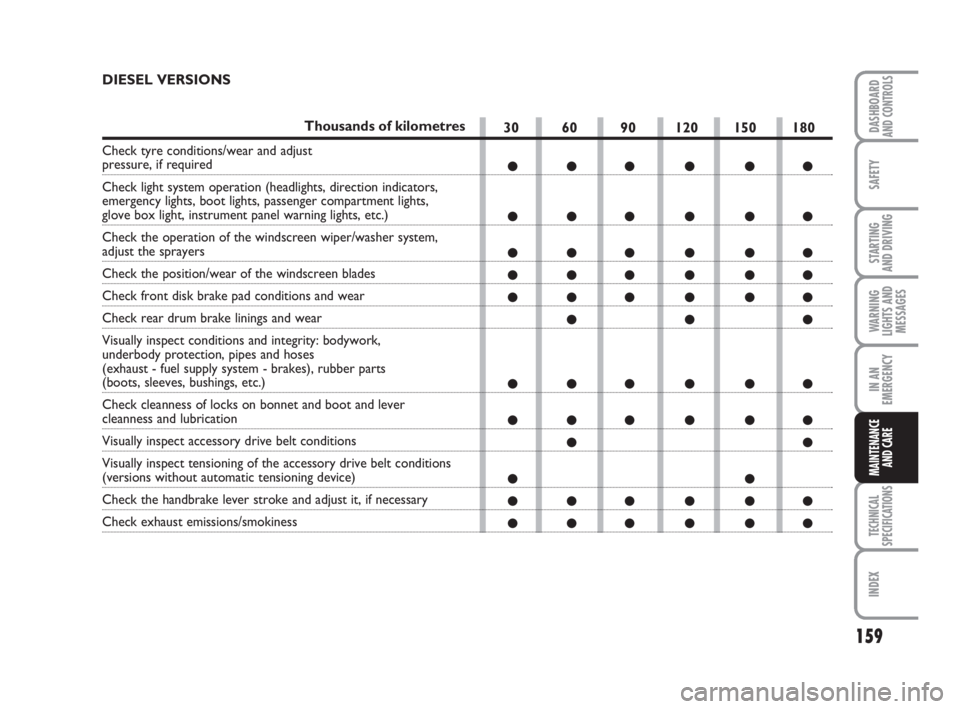
159
SAFETY
TECHNICAL
SPECIFICATIONS
INDEX
DASHBOARDAND CONTROLS
STARTING
AND DRIVING
WARNING
LIGHTS AND
MESSAGES
IN AN
EMERGENCY
MAINTENANCE
AND CARE
30 60 90 120 150 180
●●●●●●
●●●●●●
●●●●●●
●●●●●●
●●●●●●
●●●
●●●●●●
●●●●●●
●●
●●
●●●●●●
●●●●●●
DIESEL VERSIONS
Thousands of kilometres
Check tyre conditions/wear and adjust pressure, if required
Check light system operation (headlights, direction indicators,
emergency lights, boot lights, passenger compartment lights,
glove box light, instrument panel warning lights, etc.)
Check the operation of the windscreen wiper/washer system,
adjust the sprayers
Check the position/wear of the windscreen blades
Check front disk brake pad conditions and wear
Check rear drum brake linings and wear
Visually inspect conditions and integrity: bodywork,
underbody protection, pipes and hoses
(exhaust - fuel supply system - brakes), rubber parts
(boots, sleeves, bushings, etc.)
Check cleanness of locks on bonnet and boot and lever
cleanness and lubrication
Visually inspect accessory drive belt conditions
Visually inspect tensioning of the accessory drive belt conditions
(versions without automatic tensioning device)
Check the handbrake lever stroke and adjust it, if necessary
Check exhaust emissions/smokiness
155-176 Fiorino GB 1ed:155-176 Fiorino GB 1ed 30-11-2009 16:34 Pagina 159
Page 162 of 210
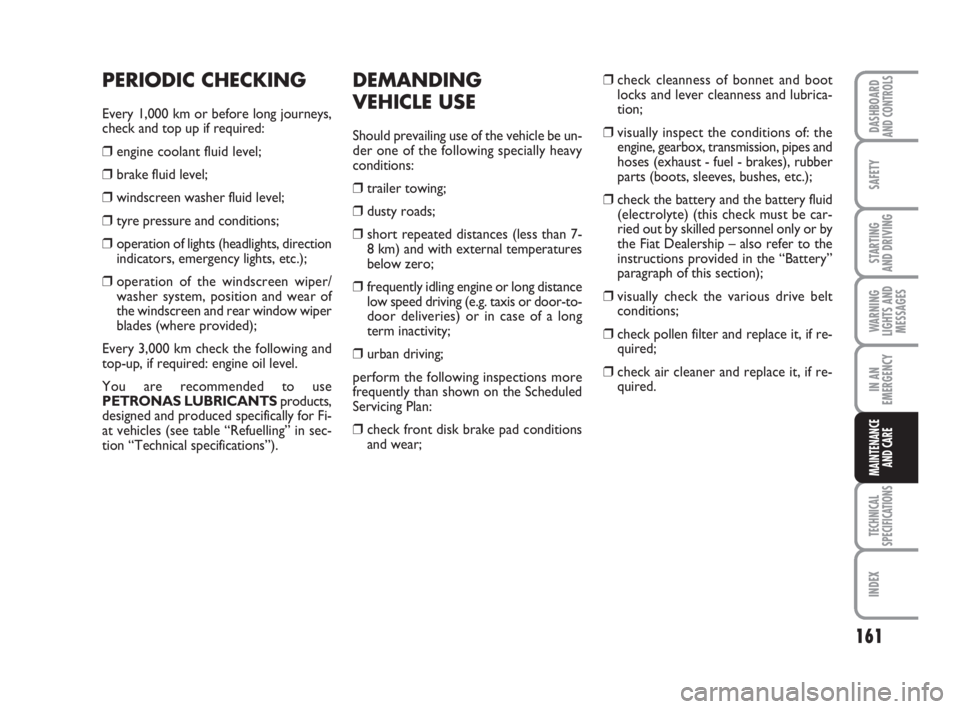
161
SAFETY
TECHNICAL
SPECIFICATIONS
INDEX
DASHBOARDAND CONTROLS
STARTING
AND DRIVING
WARNING
LIGHTS AND
MESSAGES
IN AN
EMERGENCY
MAINTENANCE
AND CARE
PERIODIC CHECKING
Every 1,000 km or before long journeys,
check and top up if required:
❒engine coolant fluid level;
❒brake fluid level;
❒windscreen washer fluid level;
❒tyre pressure and conditions;
❒operation of lights (headlights, direction
indicators, emergency lights, etc.);
❒operation of the windscreen wiper/
washer system, position and wear of
the windscreen and rear window wiper
blades (where provided);
Every 3,000 km check the following and
top-up, if required: engine oil level.
You are recommended to use
PETRONAS LUBRICANTSproducts,
designed and produced specifically for Fi-
at vehicles (see table “Refuelling” in sec-
tion “Technical specifications”).
DEMANDING
VEHICLE USE
Should prevailing use of the vehicle be un-
der one of the following specially heavy
conditions:
❒trailer towing;
❒dusty roads;
❒short repeated distances (less than 7-
8 km) and with external temperatures
below zero;
❒frequently idling engine or long distance
low speed driving (e.g. taxis or door-to-
door deliveries) or in case of a long
term inactivity;
❒urban driving;
perform the following inspections more
frequently than shown on the Scheduled
Servicing Plan:
❒check front disk brake pad conditions
and wear;❒check cleanness of bonnet and boot
locks and lever cleanness and lubrica-
tion;
❒visually inspect the conditions of: the
engine, gearbox, transmission, pipes and
hoses (exhaust - fuel - brakes), rubber
parts (boots, sleeves, bushes, etc.);
❒check the battery and the battery fluid
(electrolyte) (this check must be car-
ried out by skilled personnel only or by
the Fiat Dealership – also refer to the
instructions provided in the “Battery”
paragraph of this section);
❒visually check the various drive belt
conditions;
❒check pollen filter and replace it, if re-
quired;
❒check air cleaner and replace it, if re-
quired.
155-176 Fiorino GB 1ed:155-176 Fiorino GB 1ed 30-11-2009 16:34 Pagina 161
Page 171 of 210
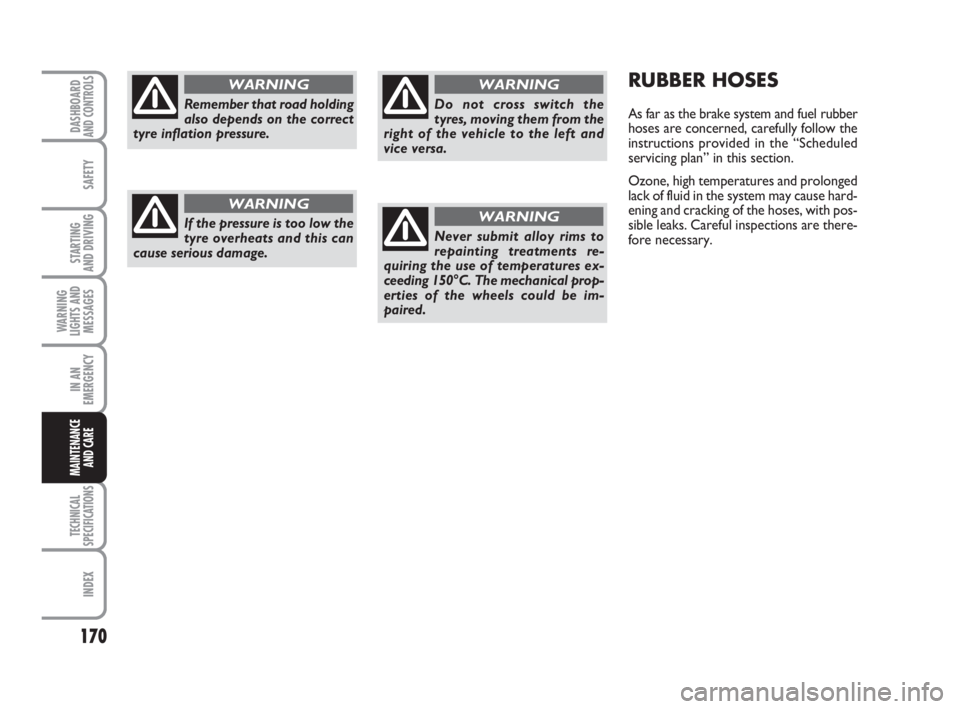
170
SAFETY
TECHNICAL
SPECIFICATIONS
INDEX
DASHBOARDAND CONTROLS
STARTING
AND DRIVING
WARNING
LIGHTS AND
MESSAGES
IN AN
EMERGENCY
MAINTENANCE
AND CARE
RUBBER HOSES
As far as the brake system and fuel rubber
hoses are concerned, carefully follow the
instructions provided in the “Scheduled
servicing plan” in this section.
Ozone, high temperatures and prolonged
lack of fluid in the system may cause hard-
ening and cracking of the hoses, with pos-
sible leaks. Careful inspections are there-
fore necessary.Remember that road holding
also depends on the correct
tyre inflation pressure.
WARNING
If the pressure is too low the
tyre overheats and this can
cause serious damage.
WARNING
Do not cross switch the
tyres, moving them from the
right of the vehicle to the left and
vice versa.
WARNING
Never submit alloy rims to
repainting treatments re-
quiring the use of temperatures ex-
ceeding 150°C. The mechanical prop-
erties of the wheels could be im-
paired.
WARNING
155-176 Fiorino GB 1ed:155-176 Fiorino GB 1ed 30-11-2009 16:34 Pagina 170